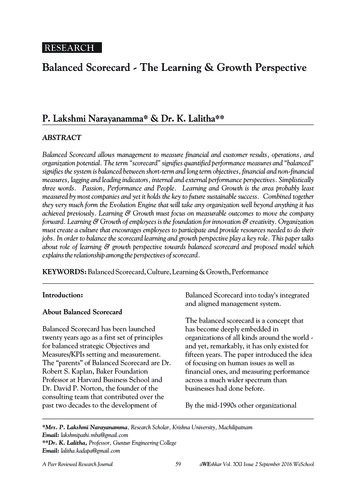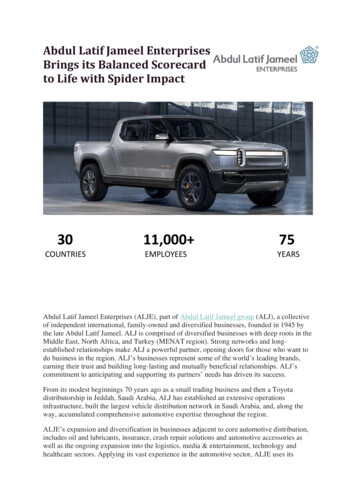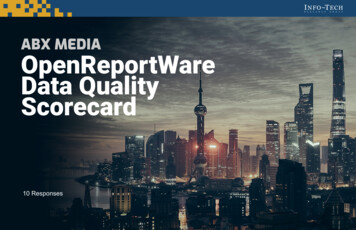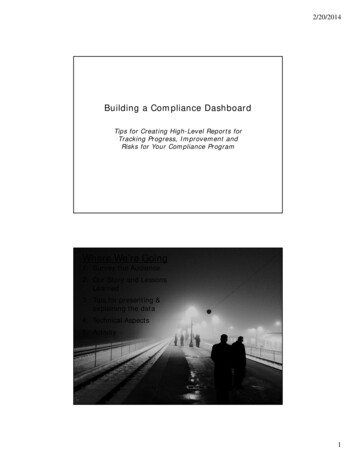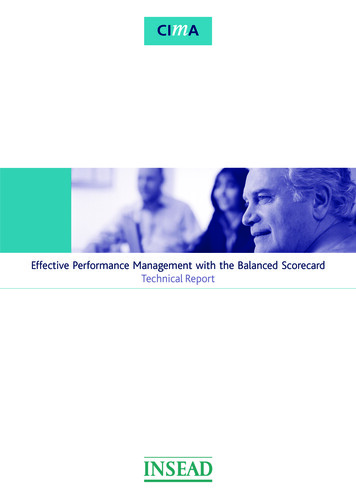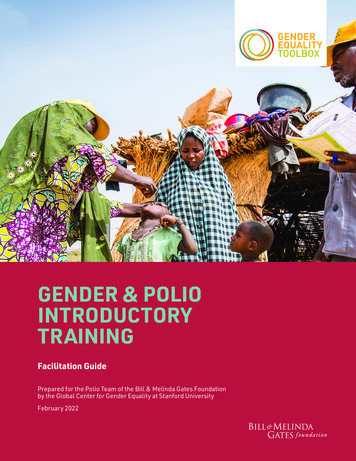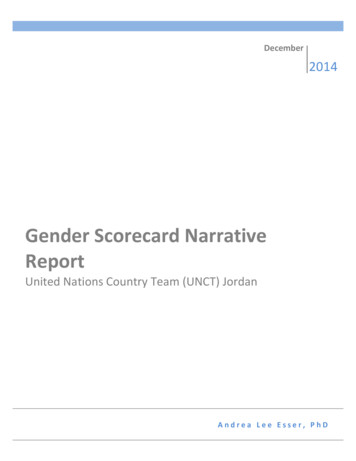
Transcription
December2014Gender Scorecard NarrativeReportUnited Nations Country Team (UNCT) JordanAndrea Lee Esser, PhD
Table of ContentsI. Background.1II. Methodology .3Jordan Context .4III. Findings .5Strong Areas – Approaches Minimum Standards and Exceeds Global Average.5Average Areas - Below Minimum Standards, but in line with Global Averages .6Weak Areas - Far From Minimum Standards and Global Averages .8IV. Recommendations. 10#1 Formulate a Visible and Coordinated UNCT Stand on Gender Equality . 10#2 Establish and Empower an Interagency Gender Theme Group (GTG) . 12#3 Prioritize GM in Joint Programs (JPs) . 14#4 Develop UN Capacity to Foster GE/WE . 16#5 Implement UNCT GRB Tracking Mechanism . 17#6 Improve Next UNDAF/UNAF Design to Deliver GE Results . 17Recommendations Recap by Budget and Scorecard Dimension Area . 18Annex A – Scorecard Results . 21Annex B – Overview of Minimum Gender Standards . 39Annex C – Gender Action Plan in UNDAF . 41Annex D – Persons Consulted . 43Annex E - Resources . 44
I. BackgroundThe “UNCT Performance Indicators for Gender Equality and Women’sEmpowerment” (Gender Scorecard) is a globally standardized rapid assessment ofthe effectiveness of UN country level gender mainstreaming processes. Designed bythe UN Development Group (UNDG), the Gender Scorecard enables the UnitedNations Country Team (UNCT)1 to assess how well gender has been mainstreamedthroughout the United Nations Development Assistance Framework (UNDAF) cycle.The tool is designed to foster adherence to minimum standards for gender equalityprocesses set by the UNDG. The Scorecard focuses on the performance of the UNdevelopment system as a whole, rather than the achievements of any one agency.By focusing on gender mainstreaming processes at the highest level, the toolhighlights the growing importance of UN interagency collaboration andcoordination to achieve common goals at the country level.The key objectives of the exercise, as outlined in the “United Nations Country Team(UNCT) Performance Indicators for Gender Equality Users’ Guide” (2008) and ascarried out in Jordan, are to: Assist the UN to assess the status of gender mainstreaming performanceagainst minimum standards and to stimulate constructive dialogue withinthe team about the status of support processes for gender equality andwomen’s empowerment;Identify successes and good practices toward fostering gender equality;Highlight shortcomings and challenges with high-level processes; andMake recommendations to a more comprehensive mainstreaming approachwithin the UN country team.The Scorecard exercise was conducted in Jordan in December 2014 toward the endof the second year of the 2013-2017 UNDAF cycle. The UNDAF drew on the 2011Comprehensive Analysis (CA), which engaged UN and partner agencies in Jordan ina consultative participatory process to identify and analyze development challenges,as well as an assessment of UN comparative advantage in Jordan. The UNDAF inJordan has undergone two revisions since its inception in response to the changingdevelopment context in the country.The influx of Syrian refugees to Jordan from 2012 on necessitated rapid changes tothe scope and focus of the UN and development partner operations in Jordan.Country programs had to adjust rapidly to operational demands, as a large-scalehumanitarian response was initiated. The UNDAF was revised in July 2014 toreflect the changing social and political context in Jordan, and to align UN operationsUNCT refers to the entire UN system in Jordan. The UNCT heads of agencies group is referred to asthe UNCT HOA.11
with the Government National Resilience Plan (Office of the Resident andHumanitarian Coordinator 2014). The UNDAF was again in the process ofadjustment at the end of 2014 to reflect the merging of the humanitarian anddevelopment arms of the UN, and to align to the Jordan Response Plan (JRP) forrecovery and resilience. The revised UNDAF was renamed the United NationsAssistance Framework (UNAF) to more accurately reflect its scope and the inclusionof the humanitarian component. The UNAF was still in draft form at the time of theScorecard exercise, so the Scorecard assessment reports against the UNDAF thatwas revised in July 2014.2 The timing of the Scorecard assessment was designed toprovide inputs into the coordination mechanisms around the UNAF, which wasexpected to be finalized in early 2015.Jordan’s 2013-2017 UNDAF outlined UN development initiatives in four priorityareas: 1) enhancing systemic reform; 2) ensuring social equity; 3) investing inyoung people; and 4) preserving the environment. Gender issues were addressed inthe UNDAF via a mainstreaming strategy that identified gender equality as a guidingprinciple and cross-cutting goal in line with UNDG guidance on countryprogramming principles.3Only some of the Scorecard indicators are tied directly to the UNDAF (most notably those under theplanning dimension); others assess different aspects of gender mainstreaming processes. The fourpriority areas of the UNDAF remain in the UNAF, so the assessment provides valid insights into thenew framework as well. The Scorecard methodology requires the implementer to make anassessment of the reality at the time of the exercise; it cannot be based on plans or intentions thatmay or may not eventuate. The decision to report against the 2014 version of the UNDAF was madeduring early discussions between UN Women, the RCO and the gender specialist.3 Gender equality is one of five UN Country Programming Principles, together with human rights,environmental sustainability, results based management and capacity development). Seehttp://www.undg.org/content/programming reference guide %28undaf%29/un country programming principles2
II. MethodologyThe UNCT Gender Scorecard measures gender mainstreaming in UN commonprogramming processes across eight dimension areas that encompass 22 indicatorsto present a holistic measure of gender mainstreaming processes. The eightdimensions center on planning, programming, partnerships, UN capacities, decisionmaking, budgeting, monitoring and evaluation, and accountability. The methodevaluates processes, rather than results, based on the logic that the UN system issolely accountable for its processes, while results depend on the collective effort ofnumerous actors and external variables that are beyond the power of any individualentity to control. Refer to Annex A for complete list of indicators.An international gender specialist worked over a five-day period in December 2014to complete the participatory data-gathering component of the exercise withfacilitation support from UN Women. The consultant utilized primary andsecondary data to inform the assessment. Following a review of key backgrounddocuments, the consultant facilitated interviews and informational feedbackdiscussions to engage key players to critically assess the status of UN gendermainstreaming processes in line with Scorecard indicators, and discussrecommendation areas. Participating stakeholders included key representativesfrom the UN, government agencies, CSO, and donors.4The research methodology enabled the consultant to view UNCT gendermainstreaming processes through the eyes of various players, thereby combiningboth insider and outsider perspectives in the assessment. The consultant assigned anumerical ranking between zero and five to each indicator in accordance with thecriteria prescribed by the scorecard. Average scores for each dimension werecalculated by combining indicator scores and dividing by the total number ofindicators within each dimension area. Full details on ranking, evidence andexplanations by indicator area are included in Annex A.Initial findings and preliminary recommendations were presented for informalfeedback and discussion to stakeholders during the course of the informationgathering component in Amman. An early debriefing session was held with UNWomen prior to finalizing the draft narrative report. Discussions aroundrecommendations and preliminary findings were designed to help tailorrecommendations to the specific context, and to ensure broader consensus oninstitutional strengths and weaknesses, and how to move forward.4See Annex D for full list of stakeholders consulted. See Annex E for a full list of secondary resources.3
Jordan ContextAs a standardized assessment tool, the Scorecard methodology does not take intoaccount the operating environment in the scoring. However, it remains importantto position the findings within the broader country context over the period of timeprior to the Scorecard exercise where pressing humanitarian demands took priorityover development demands.5 The UN and government systems in Jordan had onlyrecently stabilized at the time of the Scorecard assessment to allow for a morebalanced focus on resilience and recovery in line with the Jordanian Governmentstrategy, and this impacted findings.Despite some strains in the working relations between UN agencies in Jordanrevealed during interviews, agencies generally displayed a willingness and ability towork together. Experiences with JPs and other joint formulation processes, whileparticularly demanding in recent years, have contributed to improved intra-agencycommunication and collaboration. Although Government and CSO partner agenciesstill generally perceive the UN in Jordan as individual agencies, the country team hasmoved decisively toward stronger integration with joint communications, advocacyand programming.Efforts have been made throughout the evaluation to take into account and makenote of the influence of the humanitarian demands on the development agenda sothat the status of GM can be understood within broader systems challenges.While not affecting the scores, the context has been considered in the explanation ofthe score in the ‘comments’ included in Annex A, and efforts have been made in the‘findings’ section to explain circumstances that influenced outcomes. The contextwas also carefully considered in the design of the recommendations, andrecommendation ideas were discussed openly with key informants throughout theexercise for feedback and tailoring.A Senior Gender Advisor had been working for more than one year in Jordan to improve genderresponsiveness of humanitarian activities including the creation and development of a network ofGFPs in refugee sectors. The advisor is hosted by UNHCR, and reports to the IATF and HCT. Whilesome actors within the ‘development’ sphere may have been positively impacted, the scope of workof this initiative has been squarely within the humanitarian sector.5
III. FindingsThe findings presented below reflect the average score in each dimension. Scoreswere based on a zero-to-five rating system, with five representing the highest ratingand zero representing the lowest. The universal target for all dimensions is four orabove. A rating of four is defined as ‘meets minimum standards’. Some dimensionshave as many as five indicators, so average scores may conceal variability withindimensions. All average scores have been rounded to the nearest one-tenth. Referto Annex A for full explanation and rating of each indicator.The results reveal that the UNCT in Jordan approaches minimum standards andexceeds the global average for gender mainstreaming processes in the areas ofprogramming and partnerships. The team scored below the minimum standards,but on par with global results, in planning, M&E and quality control andaccountability. The weakest three dimension areas scored low against bothminimum standards and global averages: UNCT capacities, budgeting, and decisionmaking.UN Jordan Scorecard Results6Scorecard Dimension1 Planning2 Programming3 Partnerships4 UNCT Capacities5 Decision-making6 Budgeting7 Monitoring and Evaluation8 Quality Control and rage3.33.7333.42.52.82.7A synopsis of key findings by dimension is highlighted below, starting with areasthat scored more strongly and followed by areas that received a weaker score.Strong Areas – Approaches Minimum Standards and Exceeds Global AverageJordan’s results are presented alongside average global results for comparison purposes. Averageglobal results are from analysis of first 20 countries to undertake the Scorecard exercise (UNDG TaskTeam on Gender Equality and the Empowerment of Women 2012). Comparison reveals strongperformance in two dimension areas, average performance against global results in three areas, andbelow average performance in three dimension areas.65
Programming. The UNCT scored a 3.9, just shy of the minimum standards level, onprogramming due in large part to the existence multiple gender-targeted jointprograms that address a range of gender issues.7 UN Women has been very activelyengaged in joint program formation, and efforts have also been made to addressgender inequality in joint programs across UNDAF outcome areas. The draftprocedures for the “Interagency Project Approval Committee” include a gender‘screen’ to help formally systematize GM in JPs. The UNCT worked collectively toundertake joint advocacy and awareness-raising initiatives around key issues, mostnotably Gender Based Violence (GBV). High scores were also earned forcoordinated support for gender mainstreaming in the development of the nationalpoverty strategy, NRP and JRP as well as GRB in key ministries. There remains roomfor improvement in this dimension for gender mainstreaming in counterpartministries and in donor coordination mechanisms.Partnerships. The 3.5 score in the partnerships dimension reflects UNCTperformance across the three indicator areas that measure UNCT relations with thenational gender machinery, women’s/gender CSO and marginalized women. Thewomen’s machinery (Jordan National Commission on Women - JNCW) was involvedin the planning processes for the 2013-2017 UNDAF, although their role insupporting the achievement of outcomes is not clearly defined. Consultations heldwith JNCW revealed a desire for more active and strategic engagement with theUNCT beyond one or two agencies in order to better fulfill their mandate.Women/gender CSOs were engaged in UNDAF consultations, and they serve asimplementing partners in some aspects of elaboration, though there was a strongbelief that the UNCT was not working deeply or broadly enough with a diverserange of CSOs. There was a plea for the UN to play a stronger role to do more tobring government and CSO to the same table to address gender equality issues inJordan. CSOs still struggle to see the UN as a cohesive unit, though note that jointadvocacy events have helped this perception. Marginalized women are identified inthe CA analysis and UNDAF targeting, though they are inferred in some outputs,rather than explicitly identified. They tend to be perceived and engaged asbeneficiaries, more than as participants, in UNCT activities.Average Areas - Below Minimum Standards, but in line with Global AveragesPlanning. The average score of 3 is close to the global average of 3.3, but lowerthan the minimum standard of 4. The planning dimension, as laid out in theScorecard, puts a fine lens to the UNDAF, setting clear minimum standards forgender mainstreaming in outcomes, outputs, indicators and results. See Annex B foran overview. Jordan’s UNDAF does not meet criteria for gender sensitivity at theoutcome level because gender equality is not explicitly referenced in any of theFor example, promoting women and girls’ health, empowering rural women, addressing sexual andgender-based violence, planning and implementation for Beijing 20, and CEDAW reporting.76
outcome statements 8, although three of the four priority areas elaborate on genderissues in the prose description. Only 17 percent of outputs are framed in a gendersensitive manner 9, falling short of the minimum standard of at least one-third ofoutputs articulating tangible improvements to gender equality. Despite failing toexplicitly articulate gender equality targeting, some outputs convey a vision ofbroad-based equality with references to human rights and vulnerable groups.The minimum standard set forth in the Scorecard for indicators requires one-thirdto one-half of indicators to be gender sensitive and able to track progress towardsgender equality results. The 2013-2017 UNDAF exceeded the standard, with gendersensitivity in 64 percent of output level indicators (28 out of a total of 44 eligibleindicators).10 At 54 percent, the baselines, however, fell short of the minimumstandard of 100 percent baseline data disaggregated by sex (or gender sensitive) orthere is a specific reason noted for lack of gender sensitivity. While gendersensitivity of baselines was reasonable (e.g. percent of health centers that havereferral system for GBV victims), sex disaggregation (as an important measure ofgender sensitivity) was almost completely absent from the framework.Monitoring and Evaluation. The monitoring and evaluation dimension earned a 3,which signifies a need for improvement that is shared by many UNCTs as per globalScorecard results. The score was influenced to a degree by the fact that UN Jordandid not have an inter-agency M&E group functioning over the UNDAF design orimplementation period. The gender-specific issues with the UNDAF framework are,therefore, embedded in larger M&E issues that the UNCT must ultimately address.The UNDAF results framework did not meet minimum standards at the outcomeand output level. UNDAF indicators, however, are in line with Scorecard standards,but baselines are not. The 2013 annual review of the UNDAF faced problems withreporting in general, and baseline and target data was generally not reported perthe results framework. Instead, the consultant reported against outputs in prose,offering general indications of progress underway in indicator areas. To the extentthat data was reported in the 2013 annual review (and data was only gatheredagainst approximately half of the indicators as laid out in the results framework),gender-specific results were visible, though by no means comprehensive. The lackof sex disaggregated data was glaring. The annual review did include a separatesection in the body of the document on gender as a cross-cutting theme. The 2013RCAR does report against gender-related expected results.Minimum standards require at least one outcome to articulate the promotion of gender equality.Four out of 23 outputs make reference to gender equality.10 The indicator and baseline analysis was calculated based on figures that excluded all data that wasnot conducive to gender sensitivity or sex disaggregation (e.g. hectares of agricultural land, percentof health facilities, number of policies). This excluded 69 indicators from a total of 113, leaving 44qualifying indicators. All outcomes except #4 (investing in young people) included gender sensitiveindicators at the outcome level. Twenty-one of the 39 qualifying baselines were gender sensitive (54percent of total eligible baselines), but very few were sex-disaggregated.897
Quality Control and Accountability. Quality control and accountability earned aslightly hazy score of 3 due in part to incomplete information on the processes thatwere undertaken to mainstream gender during the design phase of the 2013-2017UNDAF. Efforts were made to provide in-house and external technical expertise totheme groups during the design phase, but the details on the quality reviews werenot available, so it was not clear the extent to which those mechanisms helped guidethe country team to mainstream gender. Based on the assessment of the finalproduct, quality review processes were insufficient with respect to gendermainstreaming in the CA and UNDAF.Weak Areas - Far From Minimum Standards and Global AveragesUNCT Capacities. With a score of 1.8, UNCT capacities to mainstream genderemerged as an area requiring attention. The score was lowered by the absence of aGender Theme Group. A GTG was established at the start of the 2013-2017 UNDAF,but it was not deemed readily effective, and meetings were halted as attentionturned to the humanitarian crisis.11 While UN Women and other UN Agencies haveworked hard to ensure gender expertise is available in key groups and initiatives,the lack of a forum to share information and contribute to broader structureslimited the ability of GFPs in UN agencies to build their capacities and make animpact collectively. The absence of a GTG also lowered scores in other dimensionareas, including the ‘decision-making’ dimension. The low score in the ‘UNCTcapacities’ dimension area was further impacted by the absence of sufficientmechanisms to develop system-wide capacities for gender mainstreaming. The UNJordan does not have a central gender expert’s roster, although agencies were ableto access gender expertise as needed through other formal and informal means.Decision-making. The score of 2.5 is significantly below both the minimumstandard and the global average. The score is negatively impacted by the absence ofthe Gender Theme Group12, which leaves no formal avenue of communication ongender equality issues between the UNCT HOA group and GFP practitioners. Areview of UNCT HOA meeting minutes over the past year (2014) revealed thatgender programming was mentioned in approximately half of the meetings,showing a reasonable degree of high-level discourse despite this constraint. Thehead of UN Women usually brought up gender issues in the UNCT HOA meetings.Budgeting. The score of 2 in this dimension reflects broader constraints within theUN Resident Coordinators Office (RCO) to capture system-wide budgetary data forplanning and monitoring purposes. The RCO was not able to report outcome-levelIssues with the GTG identified during the Scorecard interviews included low levels of seniority ofappointed staff and lack of consistent involvement of members.12 The previous existence of the GTG in UNCT Jordan is not reflected in the indicator scoring, as thescoring must take into the account the systems as they exist at the time of the assessment.118
budget data in the 2013 RCAR due to difficulties in obtaining data from agencies.This situation has been further complicated in Jordan by the Syrian refugee crisis,which has made tracking against UNDAF outcomes more difficult, as organizationsengage in both development and humanitarian work, and the line between the twooften is not distinct. A growing number of individual agencies have instituted thegender marker system, but the UNCT has yet to consider either the means oranalytical applicability of tracking gender equality expenditures at the highest level.9
IV. RecommendationsThe recommendations for the UN Jordan were designed to address weak areaswithin the eight Scorecard dimensions in order to meet minimum standardsestablished by the UNDG. The recommendations take into consideration thecomplexity of the UN machinery whereby each agency has a particular culture thatis driven by the mission and vision of the institution, and shaped by the people whocomprise the organization at a given point in time. At the same time, the UNCT has acollective obligation to coordinate its efforts in line with the vision laid out inUNDAF. By working collectively, agencies can increase both the scope and quality oftheir programming, thereby more effectively working with partner agencies toreach targets and build gender equality within broader human rights basedapproaches.#1 Formulate a Visible and Coordinated UNCT Stand on Gender EqualityPrimary Dimension Target: #1 Planning; #5 Decision-Making; #8 Accountability andcuts across all dimensionsGlobal composite indexes on gender inequality reveal Jordan to be among the worstcountries in the world for gender inequality. Jordan ranked 134 out of 142countries according to the latest World Economic Forum’s Gender Gap Index, and130 out of 187 countries for UNDP’s Gender Development Index. 13 Compositeindicators show slight declines in levels of equality in health and education; low butimproving levels of equality in political empowerment; and low and decliningequality in economic participation (WEF 2014 data comparison 2006-2014).Despite the severity of the levels of inequality, and the evidence of deterioration,there remains within the UN a lack of focused cohesion as a group on genderequality priorities. While there are committed and vocal individuals within thesystem, there is a lack of collective vision and a sense of urgency within the UNCTJordan to address gender equality comprehensively. 14 This persists despite theThe WEF Gender Gap Index compares gender differences in economic participation andopportunity, educational attainment, health and survival and political attainment (WEF 2014).UNDP’s Gender Development Index compares differences in Human Development Indicators (lifeexpectancy, schooling, GNI) for males and females. Jordan ranked 77th out of 187 countries on theHDI scale, but only 130 out of 187 countries on the GDI scale (UNDP 2014). See sites for moredetailed breakdowns.14 The observed situation is likely influenced by the protracted humanitarian crisis, which has beenan enormous stress on the system and the actors within the system. Agencies have had to makerapid adjustments to their scopes of work, and actors have had to engage in numerous coordinatingbodies and mechanisms, leading to a sense of fatigue, and a resistance to additional coordinatingmechanisms.1310
active role that UN Women and other agencies 15 have played on many fronts toengage agencies in joint programming, and to mainstream gender in key processes.The RC should take the lead on garnering high-level agreement across agencies onthe significance and urgency of GE issues in Jordan. To this end, a short UNCTJordan vision statement and gender strategy should be developed to carry throughthe end of the current UNDAF/UNAF cycle.16 Elements may include:-----Define UN position and bring this definition to the forefront of communication andprogramming at the highest level across agencies (disseminate talking points on keyissues and UN response for consistency in communication).Elevate the profile of gender concerns in broad-based advocacy especially in thefield of economy and politics.17Build government capacities for GM by engaging government GFPs in counterpartagencies in all UN agency project formulation and elaboration exercises incoordination with JNCW.18Prioritize joint action to address, in particular, women’s economic empowerment inlight of growing severity and significance of gap (e.g. flagship joint program,advocacy).Enhance donor coordination on gender by co-leading with JNCW regular genderdonor working group within broader aid effectiveness improvements 19 whileworking as a country team to encourage gender mainstreaming in other workinggroups and initiatives20.Formally commit to other relevant Scorecard recommendation areas as notedbelow.Commit to support and enable GTG mechanism as well as GM in all outcome groupsfor UNAF elaboration (see Recommendation #2).UNICEF has taken a strong position in Jordan to engage stakeholders on gender equality byproviding technical training, working on joint projects to promote gender equality, and providinggender expertise within diverse working groups.16 A consultant may be hired to facilitate this process, but it may also be done in-house. It should bekept clear and simple, maximum of 2-3 pages. The purpose is to clarify the vision and the strategicareas of targeting and coordinated interventions for the second half of the UNDAF/UNAF. This is animmediate measure to bridge the UNCT to the next UNDAF/UNAF, which should have the gendervision more comprehensively and visibly incorporated (see Recommendation #6).17 Successful efforts for coordinated advocacy, communication and programming around GenderBased Violence (GBV) offer models that can be expanded to address other issue areas.18 JNCW is mandated with coordinating and building government capacity for GM. The UNCT canraise the profile of GFPs and build their capacity simply by insisting on their involvement in allregular activities. This simple move will serve multiple purposes: demonstrate UN commitment togender equality; build line agency capacity for GM via building GFP capacities; improve GM inprojects by drawing on expertise of capacitated GFPs. This initiative would also mutually supportinitiatives under the ‘Takam
ender quality and Women's Empowerment" (Gender Scorecard) is a globally standardized rapid assessment of the effectiveness of UN country level gender mainstreaming processes. Designed by the UN Development Group (UNDG), the Gender Scorecard enables the United Nations Country Team (UNCT)1 to assess how well gender has been mainstreamed

